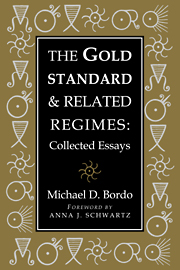Book contents
- Frontmatter
- Contents
- Foreword
- 1 The Gold Standard and Related Regimes: Introduction to the Collection
- Part I History of Doctrine and the Gold Standard
- Part II The Gold Standard as a Commodity Standard
- Part III The Gold Standard as a Contingent Rule
- 7 The Gold Standard as a Commitment Mechanism
- 8 The Operation of the Specie Standard: Evidence for Core and Peripheral Countries, 1880–1990
- 9 The Gold Standard as a “Good Housekeeping Seal of Approval”
- Part IV Historical Case Studies
- Part V The Bretton Woods International Monetary System
- Index
- Titles in the series
8 - The Operation of the Specie Standard: Evidence for Core and Peripheral Countries, 1880–1990
Published online by Cambridge University Press: 19 October 2009
- Frontmatter
- Contents
- Foreword
- 1 The Gold Standard and Related Regimes: Introduction to the Collection
- Part I History of Doctrine and the Gold Standard
- Part II The Gold Standard as a Commodity Standard
- Part III The Gold Standard as a Contingent Rule
- 7 The Gold Standard as a Commitment Mechanism
- 8 The Operation of the Specie Standard: Evidence for Core and Peripheral Countries, 1880–1990
- 9 The Gold Standard as a “Good Housekeeping Seal of Approval”
- Part IV Historical Case Studies
- Part V The Bretton Woods International Monetary System
- Index
- Titles in the series
Summary
Introduction
The classical gold standard era from 1880 to 1914, when most countries of the world defined their currencies in terms of a fixed weight (which is equivalent to a fixed price) of gold and hence adhered to a fixed exchange rate standard, has been regarded by many observers as a most admirable monetary regime. They find that its benefits include long-run price level stability and predictability, stable and low long-run interest rates, stable exchange rates (McKinnon, 1988), and hence that it facilitated a massive flow of capital from the advanced countries of Europe to the world's developing countries.
Others have taken a less favorable view of the gold standard's performance. Some criticize the record of relatively high real output and short-term price variability (Bordo, 1981; Cooper, 1982; Meltzer and Robinson, 1989), and some have faulted it for subordinating domestic stability to the maintenance of external convertibility (Keynes, 1930).
A persistent critique of the gold standard is that it provided a favorable experience for the core countries (France, Germany, the United Kingdom, and the United States), but a less favorable experience for the peripheral countries of the developing world (DeCecco, 1974). For the core countries the balance of payments adjustment mechanism was stable, so few crises occurred; the peripheral countries, by contrast, were subject to shocks imported under fixed exchange rates from abroad and frequently suffered exchange rate crises and a destabilized growth pattern.
- Type
- Chapter
- Information
- The Gold Standard and Related RegimesCollected Essays, pp. 238 - 317Publisher: Cambridge University PressPrint publication year: 1999



